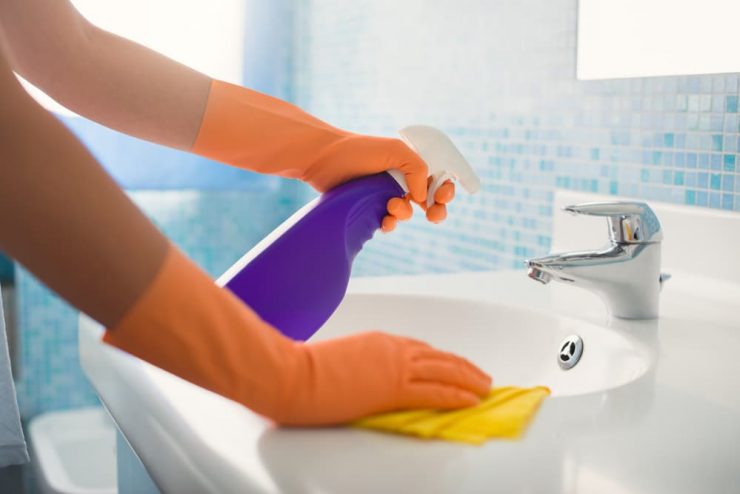Synonymous with luxury and elegance, marble floors are fitting for houses and commercial places alike. Marble is known for its evergreen, classic charm that never proves to be the wrong investment. With intricate designs and patterns, marble is available in multiple shades. However, whether you choose natural or cultured marble, its porous and delicate surface is prone to stains, loss of lustre and colour retention. Even though marble is an ideal flooring option for your bathroom, it requires extra care and maintenance. Your bathroom floor is prone to unwanted scratches, moisture damage and stains retained during colour dyes etc. If you wonder how to clean bathroom floor to maintain it properly, here are a few ways to help you out.
How to clean marble floors – Home Remedies for Stains
Baking Soda
Baking soda has many benefits in the cleaning field. It can help dissolve dirt and grime, thus getting rid of any stains or splotches. To make a marble floor cleaning solution:
- Mix some baking soda and water till the resulting paste has a sour cream-like consistency.
- Clean the floor properly to absorb the maximum stain particles you can.
- Apply the paste on the heavily stained portions of the bathroom and cover it with a plastic sheet.
- Tape it down if necessary.
- Leave it for 24 hours.
The next day, clean off the paste and wash the floor with mild soapy water. For time restraint reasons, use this method when you are planning to go away for the night.
Hot distilled water
Hot water is effective in cleaning marble floors as it cuts through grime and does not cause any harm to the texture of the stone. You can regularly use hot water and mild dishwashing detergent to clean up the bathroom floors to prevent dirt or soap scum buildup. However, it is necessary to pick a pH-neutral cleaning agent as the acidic nature can cause irreparable damage to the marble floor. You can also use any marble cleaners available in the market.
Rubbing alcohol
The marble floor can start going dark around the edges or near the toilet base. This is due to moisture exposure due to excessive water standing or dirt buildup. In such cases, you can use about a one-eighth cup of rubbing alcohol poured into a 16 oz—spray bottle. Add about two drops of mild dishwashing liquid and then fill it with water. Shake well and spray on the affected areas. Finally, rinse the floor and wipe it down with a soft mop.
Hydrogen Peroxide
Take a cotton gauze pad nearly the size of the stain you are trying to get rid of. Dip it in hydrogen peroxide and then squeeze tightly to squeeze out extra liquid. Make sure it is wet but not dripping. Now, place it over the stain and cover it with a plastic sheet—tape down the edges to keep it in place. Place a heavy object over it to ensure that the cotton gauze is entirely in touch with the bathroom floor. Let the patch rest for nearly 24 hours. Remove and clean the surface the next day. Remember, you can notice slight discolouration, so do a patch test before using it on the dark-coloured marble floor.
Best Marble Cleaning Hacks and Tips
Steer clear of moisture
Every time you use the shower space, it is bound to get wet and stay that way for a few hours unless you wipe it down after each use. It can be incredibly hectic if you are on a tight schedule. One easy way to deal with residual water drops on the bathroom floor and walls is to install a bathroom fan. When left on a marble surface, water drops can result in the accumulation of soap particles, body soil, and leftover chemicals from multiple products used. Moisture can also lead to the growth of mould and mildew. If you don’t have a fan, use a microfiber cloth or a squeegee to prevent the need for regular deep cleaning.
Deal with spills instantly
Whether you plan to colour your hair or drink some cola while relaxing in the bathtub, bathroom floor spillages are no exceptions. Due to its highly porous nature, the marble floor retains the stain very quickly. So instead of wasting your time looking up How to Clean Marble Floors, your best bet is to wipe the spilt material away quickly. Also, prevent using any soaps, shampoos or other body products that contain dyes of any kind.
Avoid harsh stuff altogether.
Marble is a naturally occurring metamorphic rock that is made up of crystals of the primary mineral grains. Due to its calcareous nature, marble is sensitive to any abrasive cleaners and acidic elements. Using lemon or vinegar as cleaning agents might result in the formation of dull spots on the surface. Avoid all harsh detergents and scrubbing brushes to keep your marble floor free from any deterioration.
Seal marble floors
As stated earlier, marble is a porous stone material. It can easily absorb any dirt, grime or coloured impurities. However, moisture itself can be very damaging for marble and leave behind stubborn stains. It can also lead to the growth of mould or mildew. To prevent any such cases, marble floors are sealed once every few years. Properly pack the grout edges and apply a second layer to ensure extra protection for your bathroom floor.
Conclusion
Having a pristine, modern bathroom with marble floors might be your fancy dream, but once achieved, the maintenance itself can be very tough. Unlike tiles, you can’t just scrub and wipe down the marble floor every once in a while to get the original shine and hygiene back. Due to its porous texture, marble is highly absorbent and can quickly get stained or dirty. In addition, bathroom floors need more care because of the ever-present moisture, which leads to the growth of mould and mildew, eventually damaging the entire floor texture. If you are wondering how to clean the bathroom floor, don’t use any harsh chemicals. Instead, look for homemade marble floor cleaners to help you out.
Frequently Asked Questions
Question 1 – How to clean a marble shower?
Answer 1 – Mix one tablespoon of mild dishwashing liquid detergent and water in a spray bottle. Choose a pH-neutral detergent to preserve the texture of the marble surface. Shake well and spray all over the floor and walls. Now, take a microfibre cloth and rub the sprayed surface in circular motions. Now, rinse the cleaned area with a hand-held shower or a bucket of water. Finally, use a squeegee or fresh cloth to dry out the surface.
Question 2 – How often should you deep clean your bathroom with marble floors?
Answer 2 – Depending on the usage of the bathroom and the daily care you take, deep cleaning should take place every month or so.
Question 3 – What are some common ways in which we can avoid wet floors in the bathroom?
Answer 3 – Keep a wiper mop in the bathroom to wipe out the surface after each use. For shower space, place a mat or rug on the outskirts so that there’s less water dripping. Take proper care of keeping the bathroom aired out or get a fan installed.
Question 4 – How to get rid of dull spots on the marble floor?
Answer 4 – Marble can lose its shine over some time. However, you can use polishing powders for marble available in the market to restore the original lustre.




























